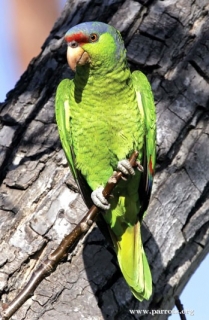Lilac-crowned Amazon |
|
|
Also known as: Lilac-crowned Parrot, Finsch's Parrot, Pacific Parrot, Wood's Red-fronted Parrot (A.f. woodi)
Photos
View in GalleryDid You Know?
The Lilac-crowned Amazon exists in feral (non-native) populations in southern California and Florida.Academic Research
Related publications: Amazona finschiSpecies Profile
Genus: Amazona | Species: finschi
Size:
33 cm (12.8 in)
Weight:
325g (11.3 oz)
Subspecies including nominate:
two: A.f. finschi, A.f. woodi
Colour Adult:
A.f. finschi: Both adults body green, with feathers edged black; maroon forehead, forecrown and lores; back of crown to sides of nape and neck blue/lilac; bases of secondary feathers 1-5 red, the remainder green; tail green. Bill horn in colour. Eye ring pale grey, eye orange.
A.f. woodi: Both adults greener and less yellowish; frontal band thinner and duller.
Colour Juvenile:
Immature as in adult but duller with dark brown eye and white eye-ring and cere.
Call:
A shrill krih-krih and other raucous calls.
Listen NowVideo Links:
Video 1More Information:
Content Sources:
CITES
BirdLife International
Cornell Lab of Ornithology/Birds of the World
A Guide to Parrots of the World, Juniper and Parr, 1998
ML Media Collection Catalogue 8426, Lilac-crowned Parrot Amazona finschi, Kincaid, Edgar, Jalisco, Mexico, Jun. 23 1957, Cornell Lab of Ornithology. Site
Parrots of the World, Forshaw and Cooper, 1989. 2010 edition
Vanished and Vanishing Parrots, Forshaw, 2017.
Parrots of the World, Forshaw, 2006.
Parrots in Aviculture, Low, 1992.
Psittacine Aviculture, Schubot, Clubb and Clubb, 1992.
Avian Pediatric Seminar Proceedings, various authors, 1988.
Photos
View in GalleryDid You Know?
The Lilac-crowned Amazon exists in feral (non-native) populations in southern California and Florida.Academic Research
Related publications: Amazona finschiSpecies Care
Captive Status:
Common in US, fairly common in Europe.
Longevity:
40-60 yrs
Housing:
Aviary or suspended cage with a minimum length 3m (9.8 ft).
Diet:
Fruit such as: apple, pear, orange, banana, cactus fruits, pomegranate, forming about 30 % of the diet; fresh vegetables such as: carrot, celery, green peas, beans, fresh corn; green leaves such as: Swiss chard, lettuce, sowthistle, dandelion, chickweed; spray millet and limited mixed seed, cooked beans and pulses, complete kibble.
Enrichment:
Loves to chew; bathing; foot toys, destructible (non-toxic) toys, non-destructible (non-toxic plastic) toys, food-finder toys, preening toys, different texture and size hanging perch toys, fir branches, push-and-pull toys (sliding up and down), vegetable tanned leather toys.
Nest Box Size:
Vertical box, 12" x 12" x 24" (30.5cm x 30.5cm x 61cm).
Clutch Size:
3
Incubation Time:
26 days
Fledging Age:
54-60 days
Hatch Weight:
11g (0.4 oz)
Peak Weight:
309-370g (10.8-13 oz)
Weaning Weight:
270-280g (9.5-9.8 oz)
Photos
View in GalleryDid You Know?
The Lilac-crowned Amazon exists in feral (non-native) populations in southern California and Florida.Academic Research
Related publications: Amazona finschiSpecies Wild Status
World Population:
7000-10,000
IUCN Red List Status:
Endangered
CITES Listing:
Appendix I
Threat Summary:
Large scale habitat loss and trapping have put the population into a very rapid decline. In Mexico and the US it is one of the most confiscated parrots and has become one of the parrot species most illegally sold on the internet.
Range:
A.f. finschi: CW and SW Mexico; feral populations reported in various areas in US.
A.f. woodi: NW Mexico.
Habitat:
Most common in wooded hills and mountains up to 1000m (3280 ft). Also found in semi-deciduous forest and margins, and pine-oak forests and mangroves.
Wild Diet:
Foods taken include unripe seeds of culebro Astronim graveolens, guayabillo Celaenodendron mexicanum; seeds and fruits of ojite Brosimum alicastrum and unripe Caesalpinia pulcherrima seeds. In the dry season Comocladia engleriana and Celaenodendron mexicanum seeds, and Ficus insipida fruits added.
Ecology and Behaviour:
Reports of altitudinal and longitudinal movements in response to food availability. Usually seen in pairs and family groups year-round, and all together in large foraging flocks. Birds return to communal roosts at night.
Clutch and Egg Size:
3 rounded eggs, 37.0 x 29.0mm (1.4 x 1.1 in).
Breeding Season:
February-June; nests are in natural cavities in trees such as Astronium graveolens, Piranhea mexicana, Brosimum alicastrum, and Tabebuia spp.
Related Links:
Photos
View in GalleryDid You Know?
The Lilac-crowned Amazon exists in feral (non-native) populations in southern California and Florida.Academic Research
Related publications: Amazona finschiMembers Only Resources
Please log-in now to find more research, resources and tools.
Not a Member?
Find more great information:
Gain exclusive access to 600+ pages of additional research, seminars and podcasts, specialists to ask your toughest questions, and dozens of other fun resources - when you become a WPT member.
Join Today >>

































